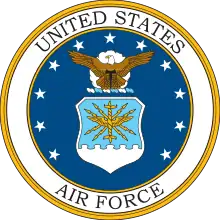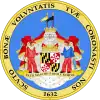104th Fighter Squadron
The 104th Fighter Squadron (104 FS) is a unit of the Maryland Air National Guard 175th Wing stationed at Warfield Air National Guard Base, Middle River, Maryland. The 104th is equipped with the A-10 Thunderbolt II.
| 104th Fighter Squadron | |
|---|---|
| Active | 1921–present |
| Country | |
| Allegiance | |
| Branch | |
| Type | Squadron |
| Role | Ground Attack |
| Part of | Maryland Air National Guard |
| Garrison/HQ | Warfield Air National Guard Base, Middle River, Maryland |
| Tail Code | "MD" |
| Insignia | |
| 104th Fighter Squadron emblem | 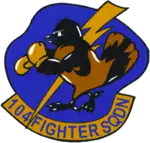 |
The squadron is a descendant organization of the 104th Squadron (Observation), which was formed on 29 June 1921. It is one of the 29 original National Guard Observation Squadrons of the United States Army National Guard formed before World War II and is the oldest unit of the Maryland Air National Guard.
Heraldry
Unit Emblem: A caricature of a Baltimore Oriole (black and orange) in a boxing stance, with wings represented as arms wearing boxing gloves, in front of a yellow lightning flash descending diagonally downward on and over a blue irregular curved background (Approved 21 September 1953)
History
Maryland National Guard

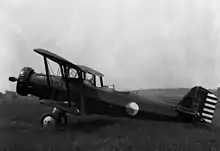
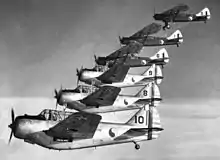
In personnel, if not in official lineage, the 104th Fighter Squadron can trace its origins to 1920 when the Flying Club of Baltimore was organized for former World War I Army Air Service reserve officers of that city. This club became part of the Maryland National Guard in 1921 when Maryland formed one of the nation's first post-war flying units with the creation of the 1st Observation Squadron in Baltimore which received federal recognition on 29 June 1921.
Maryland became the fifth state to have a post-World War I National Guard aviation unit. The 1st Observation Squadron (a state designation) was re-designated the 104th Squadron (Observation) under the federal numbering system. At the time, the number 104 was widely used to designate combat support units in the Maryland National Guard, including the 104th Medical Regiment and the 104th Military Police Battalion.
The 104th became the first post-World War I United States National Guard unit to be equipped with its own aircraft, 13 Curtiss JN-4 Jennies, which it flew until 1923. Initially assigned as division aviation for the 29th Infantry Division, the unit operated out of Baltimore's Logan Field. In addition to Jennies, the 104th flew a variety of other aircraft during the interwar period, almost all of them two-seat biplanes.
Conducted annual summer training at various locations to include Langley Field, VA; Shepard Field, Martinsburg, WV; Middletown Air Depot, PA; and at Detrick Field, Frederick, MD.
World War II
At the outset of World War II the 104th became part of the Antisubmarine Patrol used along the East Coast. Initially operating out of the Fort Dix Army Airfield, squadron was moved to the Atlantic City Municipal Airport, as part of the 59th Observation Group using O-46 and O-47 aircraft fling coastal patrol missions. On 18 October 1942, the 104th was inactivated and its personnel and aircraft transferred to the 517th Bombardment Squadron. The 517th was soon moved to Langley Field, Virginia, where it was re-designated as the 12th Antisubmarine Squadron and equipped with B-18 Bolo, and later B-24 Liberator and B-25 Mitchell bombers configured for antisubmarine attack missions.
By this time most of the original Maryland National Guard members had been transferred elsewhere as individual replacements, although a handful were still serving with the unit when it deployed to England in 1943, by which time the 517th Bomb Squadron had been redesignated the 859th Bombardment Squadron, part of the 492d Bombardment Group, Eighth Air Force, a B-24 Liberator group. There is no official lineage however, between the 104th Observation Squadron and the 859th Bombardment Squadron.
Meanwhile, the 104th Observation Squadron was reactivated with the 59th Observation Group. The squadron was redesignated as the 104th Reconnaissance Squadron (Fighter) on 1 March 1943. Equipped with P-39 Airacobras, the squadron was assigned to the 59th Reconnaissance Group, III Fighter Command. Its mission was to train newly graduated pilots from AAF flight training schools to fly single-engine fighter planes as a Replacement Training Unit (RTU). In August 1943, the squadron was redesignated as the 489th Fighter Squadron. However, those changes were administrative in nature, the mission of the squadron remaining the same. The squadron was inactivated and disbanded on 1 May 1944 as part of an Air Force reorganization of its training program. The squadron's training mission subsequently was carried out by "Squadron B", Thomasville Replacement Training Unit. With the end of the war, Thomasville AAF and all of its assigned units were inactivated on 30 September 1945.
Maryland Air National Guard
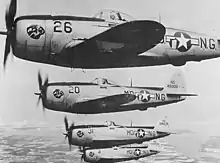
The wartime 489th Fighter Squadron was reconstituted on 21 June 1945 and re-designated as the 104th Fighter Squadron, and was allotted to the Maryland Air National Guard on 24 May 1946. It was organized at Harbor Field, Baltimore, Maryland, and was extended federal recognition on 17 August 1946 by the National Guard Bureau. The 104th Fighter Squadron continued the lineage of the 489th Fighter Squadron and all predecessor units. It was initially equipped with F-47D Thunderbolts.
Air Defense Command

The squadron was one of the first in the Air National Guard and was operationally gained by the Air Defense Command First Air Force. As the ANG command and control echelons were formed, the 104th came under the operational control of the PA ANG 53d Fighter Wing, although administrative control was retained by the Maryland ANG.
With the surprise invasion of South Korea on 25 June 1950, and the regular military's complete lack of readiness, most of the Air National Guard was federalized placed on active duty. The Maryland Air National Guard was not federalized, however its aircraft were replaced by very long distance F-51H Mustangs in 1951 to better carry out its air defense mission.
By 1955 the Mustangs were at the end of their operational lifetime, and the Air Force issued a directive to ADC to replace all of its interceptor force with Jet Aircraft. As a result, the 104th entered the jet age and received Korean War veteran F-86E Sabres to replace its propeller-driven Mustangs, which were retired. However, Baltimore Harbor Field was unsuitable for jet aircraft due to the length of its runway, and the squadron was forced to temporarily base its jet aircraft at Andrews AFB, and later at Friendship Airport (now BWI Airport), while it looked for a new home. Eventually, the squadron relocated to Glenn L. Martin Company Airport on 1 July 1957 whose longer runway was necessary to support jet operations.
Tactical Air Command
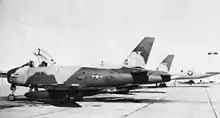
In 1957 the gaining command of the 104th was transferred to Tactical Air Command (TAC), and the squadron received the post-Korean War North American F-86H Sabre. The F-86H was a fighter-bomber version of the Sabre designed for TAC and was transferred to the ANG by TAC units being upgraded to the F-100 Super Sabre. The air defense of Baltimore and Washington, however, was retained as a secondary mission and the squadron remained under the administrative control of the PA ANG 111th Air Defense Wing, the successor unit to the 53d Fighter Wing. On 10 November 1958 the squadron was re-designated as a Tactical Fighter Squadron. The 104th flew the F-86H for over a decade, remaining in service until well after the United States had committed itself to the Vietnam war. However, no F-86Hs ever went overseas to participate in that conflict, the fighter-bomber mission in Vietnam being flown by F-100s, F-105s and F-4C Phantom IIs.
On 1 October 1962, the 104th was authorized to expand to a group level, and the 175th Tactical Fighter Group was federally recognized and activated by the National Guard Bureau. The 104th TFS becoming the group's flying squadron. Other squadrons assigned into the group were the 175th Headquarters, 175th Material Squadron, 175th Combat Support Squadron, and the 175th USAF Dispensary. With the formation of the 175th TFG, all administration of the unit by the 111th ADW ended.
On 13 May 1968 the 175th Tactical Fighter Group was federalized and ordered to active service. It was transferred to Cannon Air Force Base, New Mexico along with the NY ANG 139th Tactical Fighter Squadron and 174th Tactical Fighter Squadron as well as the 104th TFS. At Cannon AFB, the Group's mission was to act as a filler unit for the 27th Tactical Fighter Wing which were deployed to the Vietnam War. At Cannon, the squadron trained active Air Force pilots in forward air controller duties. The unit did not deploy overseas. The units were returned to New York and Maryland state control on 20 December 1968 when the TAC 4429th Combat Crew Training Squadron was activated with regular active-duty Air Force personnel.
In 1970 the F-86H Sabres were transferred after being with the 104th TFS for thirteen years. The 104th was one of the last ANG units to fly the F-86. The Sabres, however, were not retired, but instead transferred to the United States Navy which used them both as target drones and as MiG simulators for TOP GUN aggressor training. The F-86H had a similar size, shape, and performance as the MiG-17 fighter then being encountered over North Vietnam, and many a Navy F-4 pilot was "killed" by a F-86H Sabre during these mock battles.
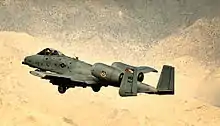
In return, the 104th TFS received Cessna A-37 Dragonfly ground-attack aircraft. In the Vietnam War, the A-37 was a very effective ground support aircraft that was simple to operate, maintain and fly. The mission of the 104th was to train in the aircraft to support Air Force and Army special forces personnel and units. In 1974, after the end of American participation in Vietnam, the unit began supporting the Military Assistance Program (MAP) by supplying training to Latin American Air Forces. In addition, in the OA-37 configuration, the aircraft was used as a Forward Air Control (FAC) aircraft, that replaced the aging O-2 Skymaster. In the OA-37 configuration, the aircraft was equipped with small rocket pods, usually with smoke or white phosphorus warheads used for target marking.
In 1979, the 175th was the first Air National Guard unit to receive the A-10 Thunderbolt II ground support aircraft. The 104th received brand new A-10A Thunderbolt II attack aircraft from the factory in Hagerstown, Maryland. The unit continues to fly the latest version (A-10C) of the famed tank killer to this day.
Modern era
Early in the 1990s with the declared end of the Cold War and the continued decline in military budgets, the Air Force restructured to meet changes in strategic requirements, decreasing personnel, and a smaller infrastructure. The 175th adopted the new USAF "Objective Organization" in early 1992, with the word "tactical" being eliminated from its designation and becoming the 175th Fighter Group. Tactical Air Command was inactivated on 1 June, being replaced by the new Air Combat Command (ACC).
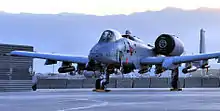
On 15 June 1996, in accordance with the Air Force "One Wing, One Base" directive, the units of the 135th Airlift Group and 175th Fighter Wing merged to form the 175th Wing. The 175th Wing became a composite organization with an Air Combat Command-gained fighter unit, an Air Mobility Command-gained airlift unit, a United States Air Forces in Europe-gained civil engineer flight, and, from 2006 to 2016, a network warfare squadron.
In mid-1996, the Air Force, in response to budget cuts, and changing world situations, began experimenting with Air Expeditionary organizations. The Air Expeditionary Force (AEF) concept was developed that would mix Active-Duty, Reserve and Air National Guard elements into a combined force. Instead of entire permanent units deploying as "Provisional" as in the 1991 Gulf War, Expeditionary units are composed of "aviation packages" from several wings, including active-duty Air Force, the Air Force Reserve Command and the Air National Guard, would be married together to carry out the assigned deployment rotation.
Following the terrorist attack of 11 September 2001, members of the 175th Wing repeatedly volunteered or have been mobilized to take part in the Global War on Terrorism. From January to June 2003, the 104th Expeditionary Fighter Squadron was formed and deployed to Bagram Air Base, Afghanistan, where it flew strikes against Taliban and al Qaeda forces and earned the distinction of being the longest-deployed Air National Guard fighter squadron at Bagram.
Lineage

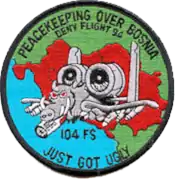

- Constituted in the National Guard in 1921 as the 104th Squadron (Observation) and allotted to the state of Maryland
- Organized and Federally recognized on 29 June 1921
- Re-designated 104th Observation Squadron on 25 January 1923
- Ordered into active service on 3 February 1941
- Re-designated: 104th Observation Squadron (Light) on 13 January 1942
- Re-designated: 104th Observation Squadron on 4 July 1942
- Inactivated on 18 October 1942
- Activated on 1 March 1943
- Re-designated: 104th Reconnaissance Squadron (Fighter) on 2 April 1943
- Re-designated: 489th Fighter Squadron on 11 August 1943
- Disbanded on: 1 May 1944.
- Reconstituted on 21 June 1945
- Re-designated: 104th Fighter Squadron and allotted to Maryland ANG on 24 May 1946
- Extended federal recognition on 17 August 1946
- Re-designated: 104th Fighter-Interceptor Squadron in Aug 1951
- Re-designated: 104th Fighter-Bomber Squadron on 1 December 1952
- Re-designated: 104th Fighter-Interceptor Squadron in Jun 1956
- Re-designated: 104th Tactical Fighter Squadron on 10 November 1958
- Federalized and ordered to active service on: 13 May 1968
- Released from active duty and returned to Maryland control, 20 December 1968
- Re-designated: 104th Fighter Squadron on 15 March 1992
- Components designated as: 104th Expeditionary Fighter Squadron when deployed as part of an Air and Space Expeditionary unit after June 1996.
Assignments
- Maryland National Guard (divisional aviation, 29th Division), 29 June 1921
- Relieved on 15 February 1929 from assignment to the 29th Division. Concurrently assigned to the 315th Observation Group (III Corps) and further attached to the 29th Division for command and control purposes
- 43d Observation Group (III Corps), 1 October 1933 – November 1940
- II Army Corps, 3 February 1941
- 59th Observation Group, 1 Sep 1942 – 18 Oct 1942
- 59th Observation Group (later Reconnaissance, Fighter) Group, 1 Mar 1943 – 1 May 1944
- Maryland Air National Guard, 17 August 1946
- Gained by First Air Force, Air Defense Command
- 53d Fighter Wing, 17 January 1947
- 111th Air Defense Wing, 1 November 1950
- 111th Fighter-Interceptor Wing, 1 July 1955
- 175th Tactical Fighter Group, 1 October 1962
- 175th Fighter Group, 15 March 1992
- 175th Operations Group, 1 April 1996 – present
Stations
|
|
Aircraft
|
|
See also
- List of observation squadrons of the United States Army National Guard
- William Tipton World War I fighter pilot who was one of the founding members of the 104th Observation Squadron, the original unit of the Maryland Air National Guard (MDANG).
References
![]() This article incorporates public domain material from the Air Force Historical Research Agency website http://www.afhra.af.mil/.
This article incorporates public domain material from the Air Force Historical Research Agency website http://www.afhra.af.mil/.
- Maurer, Maurer. Combat Squadrons of the Air Force: World War II. Maxwell Air Force Base, Alabama: Office of Air Force History, 1982.
- Clay, Steven E. (2011), US Army Order of Battle 1919–1941. 2 The Services: Air Service, Engineers, and Special Troops 1919–1941. Fort Leavenworth, KS: Combat Studies Institute Press. ISBN 9780984190140.
- 104th Fighter Squadron
- 2011 Marks Three Anniversaries for MDANG
- 175th Wing
- Turnbull and Ray Epitomized "Greatest Generation"

